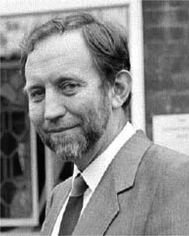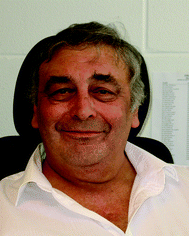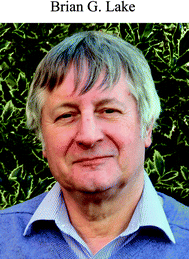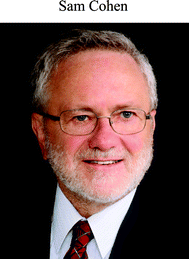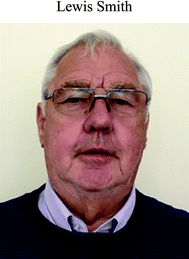Appreciation of Iain Purchase and Cliff Elcombe†
Lewis
Smith
North West Cancer Research Centre, University of Liverpool, L3 9TA, UK
The British Toxicology Society (BTS) readily agreed with the guest editorial team of Brian Lake, Sam Cohen and I that it would be appropriate to publish a special issue of their journal as a mark of respect and appreciation for the contribution that Professor Iain Purchase and Dr Cliff Elcombe made to the science of toxicology primarily, but not exclusively, through their involvement with CTL. The contributors to this issue of this journal represent a range of scientific excellence, some having worked at CTL or collaborated with CTL scientists. Others are scientists whose success in solving toxicological problems represent the ambitions of Iain Purchase and Cliff Elcombe in their approach to addressing toxicological problems.
Rational judgements and sound risk assessments on the safety of chemicals, drugs and materials can best be made on the basis of excellent science. Both Iain and Cliff understood and practised this throughout their careers. Hopefully some elements in this journal will remind us of the importance of the proper peer review of methodologies, integrity and care in the interpretation of data and the conscientious appraisal of conclusions in the process of decision making for the purpose of human wellbeing.
The contributors for this issue were chosen by the three guest editors but the peer review process was conducted in its entirety by the editorial team of the journal.
CTL
The Central Toxicology Laboratory of ICI Ltd was established in 1948 as the Industrial Hygiene Research Laboratories (IHRL) of ICI, which, by some measures, became the largest chemical company in the world. IHRL was first located near the village of Welwyn, Hertfordshire (about 20 miles north of London) with a mission to study the toxicity of chemicals produced by ICI in order to protect their employees and customers, as well as those who may experience adventitious exposure to ICI products. IHRL began with a staff of 25 who carried out relatively simple toxicity testing on a range of chemicals and offered expert advice to the company. Within 15 years it was recognized that the requirement for toxicity testing was likely to expand and new purpose-built laboratories were located in Alderley Park, Macclesfield, which was the designated site for the future development of ICI Pharmaceuticals, whose legacy companies became Zeneca and then AstraZeneca Pharmaceuticals. The IHRL facility in Alderley Park was built with the potential to house approximately 200 staff and this new facility was headed by Dr Andrew Swan. Dr Swan had the responsibility of ensuring this laboratory could evaluate a wide-range of the chemicals and materials that were produced by the 130![[thin space (1/6-em)]](https://www.rsc.org/images/entities/char_2009.gif) 000 employees of ICI in an environment where the requirements for toxicity testing were evolving rapidly with increasing regulatory oversight. Dr Swan's vision for IHRL was that it should establish a range of research programmes to ensure it was operating at the cutting edge of science, and in particular to promote research on the mechanisms of toxicity to increase the understanding of the underlying causes of toxicity. By 1973 it was decided to change the name of IHRL to the Central Toxicology Laboratories which in time became simply known as CTL.
000 employees of ICI in an environment where the requirements for toxicity testing were evolving rapidly with increasing regulatory oversight. Dr Swan's vision for IHRL was that it should establish a range of research programmes to ensure it was operating at the cutting edge of science, and in particular to promote research on the mechanisms of toxicity to increase the understanding of the underlying causes of toxicity. By 1973 it was decided to change the name of IHRL to the Central Toxicology Laboratories which in time became simply known as CTL.
The early 1970s was a time of rapid expansion of CTL with the establishment of additional research groups, including a section on mechanisms of toxicity headed by Dr Michael Rose who was recruited from the UK Medical Research Council Toxicology Unit, and Dr Iain Purchase from the South African National Research Institute for Nutritional Diseases headed the Experimental Pathology Unit.
Iain Francis Harvey Purchase
Iain Purchase was born in 1937 in Livingstone, Rhodesia (now Zimbabwe). His father was a veterinary surgeon who worked for the British Colonial Service. Both Iain and his brother, Harvey, followed in their father's footsteps and entered veterinary school at the University of Pretoria, South Africa. Iain was awarded a BVSc in 1959 and subsequently moved to the University of Cambridge, UK. He was made a member of the Royal College of Veterinary Surgeons (MRCVS) in 1960, followed by his PhD from Cambridge in 1964. Iain's PhD studies had focused on the use of anaesthetics in veterinary medicine and from these studies he published several papers including a single author publication in Nature on the “estimation of halothane tension in blood by gas chromatography”.
Iain returned to South Africa where he joined the Division of Toxicology at the National Nutritional Research Institute based in Pretoria. He was interested in the pathology of liver cancer associated with exposure of animals and humans to natural chemicals including aflatoxins, ochratoxin A, sterimatocystin and other mycotoxins. He published several important papers in this area of research and in 1970 was appointed director of the National Research Institute for Nutritional Diseases. While in this position Iain met, the then Research Director of ICI, Sir Alfred Spinks who recommended Iain for a position at IHRL, which was, as stated before, expanding rapidly. Iain joined IHRL in 1972 as head of the experimental pathology section. For the next decade Iain concentrated his efforts on establishing his team of scientists as an internationally recognized center of excellence in the evaluation of chemical carcinogens. Iain had championed the use of in vitro testing protocols for the characterisation of mutagens and carcinogens. His multidisciplinary team included John Ashby, Eric Longstaff, Diane Anderson, Jerry Styles and others who were responsible for the Nature paper “evaluation of six short-term tests for detecting organic chemical carcinogens and recommendations for their use”. This proved to be a highly significant publication as it provided validation for the use of and the relative effectiveness of these tests in evaluating the carcinogenic potential of chemicals. This highly productive group became widely appreciated as thought leaders in the evaluation of carcinogens and the use of in vitro and in vivo methodologies to evaluate their potency.
Iain was appointed deputy director of the now-renamed CTL in 1978 and then director in 1981. This change in status and responsibility allowed Iain to broaden his influence in the world of toxicological sciences. He exerted considerable influence on international affairs in toxicology through his appointment to various national and international committees. He became a member of council of the British Industrial Biological Research Association (BIBRA), with particular interests in food, consumer products and the environment, supported by the Department of Health (UK). He sat on the committee on the surveillance of food on behalf of the Ministry of Agriculture, Fisheries and Food (MAFF). He sat on the advisory committee on toxic substances as part of the health and safety executive of the UK. He was elected chairman of the British Toxicology Society and to the executive committee of IUTOX and subsequently was elected President of IUTOX. Through these appointments, and other committees which have not been mentioned here, Iain developed an extremely broad portfolio of interests which made him extremely influential in giving advice on national and international issues in toxicology and risk assessment.
At CTL Iain provided a scientific environment with a broad-based range of intellectual and technical capabilities and an extensive research portfolio. CTL became a source of some truly seminal discoveries in the science of toxicology. Moreover, under Iain's guidance a generation of talented toxicologists flourished and many of those who benefited from working under Iain's membership went on to forge successful independent careers.
Iain himself made important contributions to the science of toxicology, his main research interests being in the hazard and risk assessment of chemical carcinogens. In parallel, Iain played a pioneering role in the development of in vitro toxicology and the application of the 3 Rs principles (reduction, refinement and replacement) to the toxicological sciences. He was the founding editor of the journal ‘Toxicology in vitro’ when it was launched in 1987 and was the leading editor until 1994. Iain was also one of the founders of ‘Practical in vitro Toxicology Conference Series’. In 1993, Iain received, on behalf of CTL, the John Hopkins C.A.A.T. Recognition Award for ‘the development of mechanistically-based alternative in vitro and in vivo toxicological methods, and their application to improve human hazard assessment, to improve early chemical selection and to refine regulatory protocols’.
During his 17 years as director of CTL Iain presided over the expansion of the laboratory to more than 400 staff. During this period, ICI was split into three different components and CTL became part of Zeneca (1993), which itself had three businesses - pharmaceutical, agroscience and speciality chemicals. CTL was responsible for much of the toxicity testing for the latter two of these businesses, as well as contracting its services to the remnants of the original ICI business on a commercial basis. Iain's achievement during this process and beyond was to maintain the high quality regulatory toxicology function, which was necessary for business, and to continue to maintain and develop the research capability of CTL. Iain encouraged the rapid growth in molecular biological expertise, as well as the ‘omics’ revolution, with which we are so familiar today. At the same time as the science was evolving the external environment was changing rapidly. Some companies merged or were taken over and other organisations developed the capacity and capabilities to provide regulatory services for the industry at large and CTL had to respond to this pressure to remain competitive to its internal market. The stock of credibility that Iain had acquired over his years within ICI and Zeneca enabled him to work with the top management of Zeneca in support of the continued role of CTL as both a regulatory and research organization.
Iain's achievements were recognised by many prestigious awards. Amongst these were the IUTOX Merit Award (2004), the highest honour conferred by the society and in the same year he was awarded the Paton Prize by the BTS. In 1998 he became an Officer of the Order of the British Empire (OBE) for services to toxicology in the Queen's Birthday Honours List and was also awarded La Medaille de la Ville de Paris.
In this appreciation much of what is written is in the public domain, what is not so obvious, except to those who saw how Iain worked and experienced his influence, is Iain, the man. He was blessed with a pleasant personality and was keen to hear a range of opinions. Although clear in his judgement, he was not arrogant in the defence of his positions. However, it was the depth of his integrity and honesty, both in the conduct of science and at a personal level, that most characterised Iain Purchase. He sought to be fair-minded and, for the most part, those who worked with him benefited from his leadership.
Iain retired from Syngenta in 1998 and took up a position as visiting professor at Manchester University School of Biological Sciences and Institute of Medicine, Law and Bioethics, where he pursued his interests in the attitude of research workers in the UK to experimental animals as well as attitudes to ethics, animal welfare and training. In 2003 he became a non-executive director of the Eastern Cheshire Primary Care National Health Service (NHS) Trust and chair of the finance and performance committee. In 2006 the trust expanded to include both North and East Cheshire for which he became vice-chair. His last appointment was as a non-executive director of the Cheshire, Wirral and Warrington NHS trust. This was a commissioning body for one million patients with a budget of nearly £3billion per annum.
In the early 2000s Iain developed Waldenstrom's macroglobulin anaemia, a rare form of non-Hodgkins lymphoma, which was kept under control for over a decade through frequent hospital visits. In the end the cancer became uncontrollable.
Iain is survived by his wife Sheila, their four children and nine grandchildren.
Clifford Roy Elcombe
Clifford Roy Elcombe was born on 24th October 1950 in Dartford, Kent. He attended Dartford Grammar School (1960–1969) and then completed his BSc in biochemistry at the University of Surrey (1969–1972). In the 1960s and for two further decades, the University of Surrey was probably the most renowned university in the UK for its toxicological sciences. It had earned an enviable reputation for studies on xenobiotic metabolism and produced many postgraduate toxicologists who became well known in national and international laboratories. Cliff remained at the University of Surrey to continue his PhD studies in the laboratory of Jim Bridges and completed his thesis on the hepatic microsomal metabolism of methylenedioxyphenyl compounds (1972–1975). During his PhD, Cliff worked as a Royal Society research fellow in the laboratory of Karl Netter (University of Mainz) and collaborated with Roland Wolf on Cliff's first publication (in Xenobiotica). On completion of his PhD, Cliff moved to the College of Medicine, University of Wisconsin, where he worked with Dr John Lech on the metabolism of polybrominated biphenyls in rainbow trout (Salmogairdneri). He and John Lech subsequently described the induction of cytochromes P450 in the rainbow trout. Cliff's PhD and his first postdoctoral period in Wisconsin were highly productive and he was already building his scientific reputation in the field of chemical and drug metabolism. In 1979 Cliff was invited to lead a work group in the relatively newly-formed biochemical toxicology section led by Mike Rose in the Central Toxicology Laboratory (CTL) of ICI Ltd. It was in this laboratory that, during the next two decades, Cliff, along with his colleagues Martin Ellis, Trevor Green, Ted Lock, Marsh Middleton, Mac Proven and Lewis Smith, established an international reputation for studying the mechanisms of toxicity of various classes of chemicals. Cliff and his colleagues investigated and published on the metabolism of various xenobiotics of interest to ICI. He was amongst the first in the field to recognize the importance of chemically induced non-genotoxic carcinogenesis. More importantly, Cliff recognized that the species differences in the response of experimental animals to treatment with the same xenobiotic meant that the challenge was to establish how human tissue responded since this would have significant implications for the registration and safe use of chemicals that produced cancer in experimental animals.
Early in his studies of xenobiotic mechanisms of toxicity, Cliff initiated studies on the role of peroxisome proliferation in the differing carcinogenic outcomes seen in various species of experimental animal. During the 1980s and 1990s Cliff and his colleagues worked on the metabolism, induction of peroxisomes and carcinogenicity of several chemicals of scientific interest and/or industrial importance. He concentrated on comparing the effects of peroxisome proliferators on hepatocytes in vitro with their effects in whole animals. Cliff used several species of experimental animal to establish the correlation between in vitro and in vivo results, and then used human hepatocytes to establish the likely effect of exposure of humans to the xenobiotics under investigation. He initiated long-term toxicity studies on various xenobiotics to establish if his predictions of outcome from in vitro studies were correct. These studies, taken with results from other international laboratories, greatly influenced the discussion of the relevance of non-genotoxic animal carcinogens to humans, and in the long-term challenged the value of the two-year carcinogenic bioassay. Of more scientific importance was the influence of Cliff's work on the identification and characterisation of peroxisome proliferator-activated receptor, alpha (PPAR α) by Stephen Green (at CTL) and the subsequent study by scientists throughout the world on the various additional forms of PPAR and their role in human disease. Cliff's studies on the species specificity of peroxisome proliferators and on the mechanism of trichloroethylene-induced liver cancer led to the award of ‘Young Scientist of the Year’ in 1984, by the European Society of Toxicology.
In 1987 Cliff's contribution to the science of CTL was recognised by his appointment to the ICI scientific ladder as ‘Senior Scientist’. This was a rare honour as the position was reserved for individuals who had demonstrated that their academic achievements were equivalent to that of a professor in a university.
Cliff was invited to sit on various scientific committees, including the ECETOC (European Chemical-Industry Ecology and Toxicology Centre) task force on the relevance of animal tumours to humans (1980–1982) and the task force on liver cell proliferation. He also acted as a consultant to the IARC (International Agency for Research on Cancer) on peroxisome proliferators and as an invited expert to the IPCS (International Program on Chemical Safety) (1998–1999), as well as a member of the advisory committee on pesticides for the UK (2001).
In 1997 Cliff decided to move to the University of Dundee where he was reunited with Roland Wolf, who was now responsible for a successful research program within the University. Cliff and Roland continued to work on the mechanism of epigenetic carcinogenesis, which led them to establish an independently funded company known as CXR Biosciences Ltd, in order to commercialise the application of their expertise and knowledge.
Through this organization, Roland and Cliff maintained an active research program on the relevance of the metabolism of xenobiotics and the implication of this for their carcinogenic potential. CXR continued to work for various industrial organizations, including CTL as well as with other companies with an interest in mechanisms of toxicity. CXR developed an enviable reputation as a scientific resource for solving industrial toxicological problems. In 2008 the CXR business accelerated. Cliff, as research director contributed to this expansion by working with the new staff to broaden the customer base and develop a team of toxicologists necessary to meet the challenge of an expanding business. By 2015 the revenue of CXR had grown five-fold and that year the company was acquired by Concept Life Sciences Ltd.
By the time of CXR's acquisition in 2015 the company was more than 40-strong. Cliff, along with Brian Lake, helped to establish the importance of the activation of the constitutive and androstane receptor (CAR) in a proposed mechanism of non-genotoxic carcinogenesis.
The reputation forged by Cliff has established a laboratory where mechanisms of toxicity are investigated, often in collaboration with scientists from international companies to the benefit of science as well as to these businesses.
There is no doubt that Cliff Elcombe the scientist made a significant contribution to our understanding of the mechanisms of non-genotoxic carcinogenesis. He had an enormous intellect for scientific issues. Those of us who worked closely with him would observe him casually, almost absent-mindedly, reading Nature or other scientific journals. He would be asked ‘what's new’ and his almost frighteningly detailed description of what was in the latest journal would be given. It almost seemed as if he learned by osmosis because he did not have to study the paper to establish the essence of its ‘message’.
During his career, Cliff has supervised tens of PhD students, some directly, and others he co-supervised. He was always interested to know what they had discovered and what they thought they had achieved. He could be critical and didn't like any kind of ‘waffle’ or his more vernacular term for it. His post-docs benefited from working with him and he was conscientious in ensuring that the best found good research opportunities, and the others employment.
No acknowledgement of the humanity of Cliff would be complete without acknowledging two striking characteristics:
First, Cliff loved to socialize with his workmates and scientific colleagues. As a younger man he could burn the candle at both ends and then some. He was open and generous and critical and instructive, almost at the same time. He had a terrific sense of humour and was able to take as well as give. He was knowledgeable about cricket and had played for the county of Kent's under 21s and then with local teams depending on his location.
He was knowledgeable about wine, cheese and cooking (which was his form of practical chemistry) and was always an interesting companion. Some could see no further than this terrifically social, and sometimes dominating presence. For those who worked with him there was a deep respect for what he knew and for his opinions, a kind of almost annoying acceptance that, even if he was not entirely right, he was very close to the solution of where the problem lay and if you were going to argue with him, you needed to be well-prepared.
Second, Cliff was fiercely loyal to his wife, children, those who worked for him and his friends. It was a brave person who tried to criticize any of the aforementioned. His love for his family was evident when he talked of them. Cliff only wanted the best for them and was a proud, inspirational father who was at his most benign and gentle when telling how they were. His untimely death came tragically only a week before one of his sons was due to marry.
The science of toxicology is poorer today for the loss of Cliff, but it is richer for his contribution to the role of mechanisms in human risk assessment. For those who worked with, or knew, Cliff we are richer for having known the man.
In short, Dr Cliff Elcombe was a well-known and accomplished British toxicologist, who spent almost his entire career investigating the mechanisms of toxicity of various industrial chemicals and agrochemicals. He had an enviable reputation for his knowledge of, and insight into, non-genotoxic mechanisms of carcinogenesis and was internationally recognized for his work in predicting whether adverse effects of chemicals seen in experimental animals were likely to be replicated in the human population. The development of the role of mechanisms of toxicity in human risk assessment analysis has greatly enhanced the science of toxicology from that of an observational science into a more rational predictive science. Cliff Elcombe was one of the leading exponents of this philosophy, which helps to avoid exaggerated concerns of toxicity of chemicals as well as establishing the identity of those compounds to which humans should not be exposed.
Cliff died suddenly after a short illness. He is survived by his wife, Barbara, three children and one grandchild.
Lewis L. Smith PhD, FRCPath, FBTS
Director CTL (1998–2003)
I would like to thank Ted Lock, Mike Piper, Mary Ballantyne, Brian Lake and Sam Cohen for their contribution to the above.
Footnote |
| † In 1999 Zeneca Ltd and Astra Ltd merged to form AstraZeneca and shortly thereafter Syngenta, an agroscience company, was established from the merger of the non-pharmaceutical parts of AstraZeneca and Novartis (2000). Syngenta CTL continued toxicological research and to provide safety assessments for Syngenta and some external organisations. In 2006 it was announced that CTL would cease to operate after 2008. Syngenta, driven by the purpose of improving shareholder value, decided that no human or environmental safety laboratory work would be carried out within the company and that the required laboratory safety assessments would be undertaken by external contractors and research in toxicology would cease. The irony of this decision seems lost on the higher paid help in Syngenta. The business of developing agrochemicals, and to some extent genetically engineered plants, is in essence a toxicological challenge. The design, development and distribution of products that harm weeds or kill specific pests or selected plants, but do no harm to the spray operator or desired plants, insects or wildlife is essentially a comparative toxicity problem. The capability to do this is fundamental for the safe use of chemicals and the safety of consumers. To decide not to invest in a key competence for the core of its business is unusual. For some the closure of CTL was an example of scientific vandalism. |
| This journal is © The Royal Society of Chemistry 2018 |

